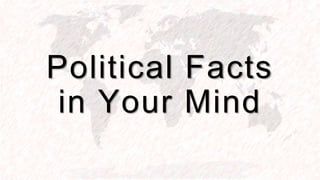
Political Facts on Child Soldiers, Refugees and Human Rights
- 1. Political Facts in Your Mind
- 2. Children of War I How many of today’s living children of war approximately report about traumatic experiences, especially related to their experience from WWII? 10-20 % 20-30 % 40-50 % 60-70 %
- 3. Children of War I 40-50 % This percentage refers to the research of the psychologist Dr. Heide Glaesmer from the university hospital Leipzig. Her study covers people from the age of 70 who describe their experiences during WWII and the post-war period.
- 4. Children of War II How many children of allied soldiers were born in post-war Germany? about 50,000 about 100,000 about 200,000 about 400,000
- 5. Children of War II about 400,000 These numbers refer to the newest studies of the historians Barbara Stelzl-Marx and Silke Satjukow. Often Children of allied soldiers were confronted with hostilities. Most of them grew up without their father.
- 6. Child Soldiers I How big is the number of child soldiers worldwide according to UN estimates? about 100,000 about 250,000 about 500,000 about 1,000,000
- 7. Child Soldiers I about 250,000 The UN defines child soldiers as children under the age of 18 who fight in armed conflicts. These are official numbers. The number of unreported cases is probably much higher.
- 8. Child Soldiers II Which of these countries did not deploy child soldiers in 2014? Saudi Arabia Nigeria Thailand Colombia
- 9. Child Soldiers II Saudi Arabia The other listed countries deployed child soldiers in armed conflicts in 2014. Beyond that, child soldiers fought in the conflict areas of Africa, Near and Middle East and South Asia.
- 10. Children‘s Rights Which country did sign the UN Convention on the Rights of the Child but not ratify it, which means they do not implement it in their national law? Afghanistan USA Sudan Vatican City State
- 11. Children‘s Rights USA The UN Convention on the Rights of the Child was ratified by more states than any other UN convention, namely every UN member state except of South Sudan and the United States. The US decline a ratification for many reasons, e.g. because of the restriction of the parents’ rights regarding the education of their children.
- 12. Human Rights Which of these statements stands at the beginning of the first article of the Universal Declaration of Human Rights (Dec. 10, 1948)? All are equal before the law and are entitled without any discrimination to equal protection of the law. Everyone has the right to life, liberty and security of person. Everyone has the right to recognition everywhere as a person before the law. All human beings are born free and equal in dignity and rights.
- 13. Human Rights All human beings are born free and equal in dignity and rights. The Universal Declaration of Human Rights was established by the United Nations in 1948. All of the above-mentioned phrases are part of it, namely the articles 7, 3, 6 and 1.
- 14. Refugees When was the Convention relating to the status of refugees, passed in Geneva, legally decided? Jan. 16, 1921 July 28, 1951 Dec. 9, 1967 Apr. 30, 1992
- 15. Refugees July 28, 1951 lready at the beginning of the 20th century, the League of Nations (the predecessor organisation of the United Nations) started the development of a legal foundation for the protection of refugees with international validity. The 1951 Refugee Convention focused mainly on the refugee wave in post-war Europe. It was extended in 1967 (New York protocol). 147 states joined the 1951 Refugee Convention and/or the 1967 protocol.
- 16. Refugees How many of the worldwide almost 60 Million refugees in 2014 were under the age of 18? 10 % 25 % 50 % 70 %
- 17. Refugees 50 % 38 million of them are so-called internally displaced person (refugees in their own countries). 20 million took refuge in foreign countries because of war, poverty and persecution. In addition, there are 2 million asylum seekers. 25 % of people fleeing to Europe are under the age of 18.
- 18. Refugees How many people fled on average per day in 2014? 7,200 23,700 42,500 58,400
- 19. Refugees 42,500 This number is based on the current reports of the UNCHR (United Nations High Commissioner for Refugees).